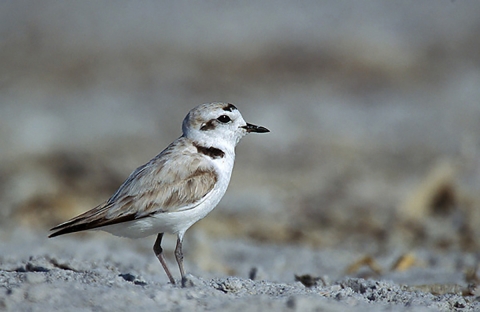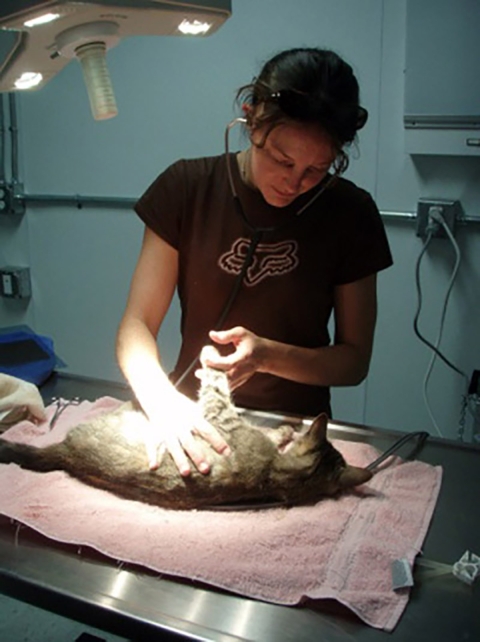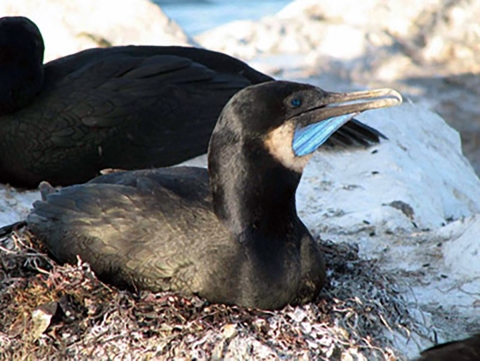Five, ten, or even fifteen years from now, when ecologists, wildlife biologists, conservationists and environmentalists worldwide look for an example to follow for future island restoration partnerships and efforts to remove feral animals, the San Nicolas Island Seabird Restoration Project will be at the top of the list.
The most remote of California's Channel Islands, San Nicolas Island, lies approximately 60 miles (96 kilometers) off the state’s southern coast. With a varied topography of canyons, dunes, flatlands, and beach areas, the island supports an array of endemic species including the San Nicolas Island fox (Urocyon littoralis), island night lizard (Xantusia riversiana), and native deer mice (Peromyscus maniculatus). Other species such as northern elephant seals (Mirounga angustirostris), Brandt's cormorants (Phalacrocorax penicillatus), western gulls (Larus occidentalis), and federally threatened western snowy plovers (Charadrius alexandrinus nivosus) breed and rear their young there.
Beginning with occupancy by the Nicoleño Indians approximately 12,000 years ago, through ranching operations of the 19th Century, to its current site as a U.S. Navy missile testing area, San Nicolas Island has been touched and transformed by humans for thousands of years. Military presence and sheep ranching also altered the island's historic ecosystem since the 1940s. However, under the stewardship of the Navy, the island is slowly recovering. The removal of sheep has enabled native vegetation to take root again, and efforts to protect native species from unnecessary disturbances have helped restore a more natural biological rhythm.
Nevertheless, one introduced predator, the feral cat (felis catus), continued to wreak havoc on native wildlife, and proved to be a difficult animal to remove.
The origination of the cats occupying the island is unknown, but it is thought that the cats were first brought to San Nicolas Island by military personnel in the 1950s to keep mice out of food supply; however, the cats were left on the island as members of the military returned to the mainland. The cat population expanded to roughly 200, and as a result, native seabirds, which nested on the ground, were preyed upon.
Until the arrival of cats on the island, the only predator of ground-nesting birds like the cormorants, gulls, and plovers was the island fox. Standing about one foot (0.3 meters) high and weighing an average of 4 pounds (1.8 kilograms), the island fox feeds primarily on native deer mice, beetles, crickets, and plant fruits. The more aggressive introduced cats directly competed with the fox for food sources, primarily deer mice, and they also preyed on the native seabirds, their eggs and young. In addition to predation, seabirds on the Channel Islands, including San Nicolas, have been affected by the dumping of DDT into the marine environment. The chemicals were dumped into the ocean off the coast of Los Angeles County through an outfall pipe. Unchecked discharges of these chemicals continued for about 40 years. Bald eagles (Haliaeetus leucocephalus) disappeared from the islands by the 1960s, and native seabird populations declined. The concomitant effects of contaminants and the introduced cats were a double threat to the native seabird colonies on San Nicolas Island.
After a multi-year effort, the final settlements were reached in 2000 with the Montrose Chemical Company and others regarding the pollution of the marine environment caused by the dumping of DDT. Using $30 million in restoration funding, the Montrose Settlements Restoration Program identified high-priority restoration projects, one of which was the removal of the feral cats from San Nicolas Island to improve seabird nesting success.
Representatives from the Montrose Settlements Restoration Program Trustee Council approached the Navy in 2004 to determine if the removal of feral cats from the island was a project the Navy would support. It was clear from the outset that even with support from the Navy, the removal of the feral cats would be a complex undertaking. Materials and personnel would have to be flown or shipped out to the island; the process of removing the feral cats would have to yield to military activities; and any efforts to remove the feral cats would have to be done in a way that would cause the least amount of disruption or harm to the island's native inhabitants, in particular the island fox. One additional hurdle to be overcome was public sentiment toward euthanasia. A a plan that called for lethal removal of the cats would face opposition from the public, as well as several animal welfare groups including the Humane Society of the United States (HSUS); however transferring them off the island to the mainland into other feral cat colonies would continue the destructive cycle of cats preying on native wildlife.
In 2007, a partnership was formed with the HSUS and Fund for Animals, and other national animal welfare groups to find a common ground. A compromise was reached soon after to develop a pilot trapping program.
The padded leghold live trap was found to be the most effective method to minimize the risk of injury to the cats. Each trap was equipped with a sophisticated telemetry system that immediately alerted project staff on the island when it was sprung. This system minimized the amount of time a cat spent restrained. Once the cats were removed from a trap, they were transported to a mobile veterinarian hospital established on the island for a health assessment.
In June 2009, extensive planning and active removal of the feral cats began. The trapping efforts continued until January 2010, when the island fox breeding season began, and then the final two cats were detected and removed in June 2010. A total of 66 adult cats and 10 kittens were removed from San Nicolas Island. Two years of monitoring the island using remote cameras, which have not detected the presence of any cats. The project has been concluded as 100 percent successful.
"The removal of cats from San Nicolas Island is an enormous complement to our ongoing Integrated Natural Resource Management Program, and will help restore the natural balance to the island's ecosystem," says Dan Shide, Installation Environmental Program Director at Naval Base Ventura County. "We look forward to the future of San Nicolas Island and will continue to work with our partners and partnering agencies, as we move onward in our stewardship and observe the long term natural resource benefits from the Seabird Restoration Project."
San Nicolas Island is the fifth largest island in the world to have successfully removed all feral cats, and it is the largest one to do so without the use of poison.
In accordance with Sikes Act Improvements Act, the Integrated Natural Resource Management Plan for San Nicolas Island identified the removal of feral cats as an important project to benefit native wildlife. Beginning in the 1980s and continuing periodically through 2005, the Navy sought to remove the feral cats, but they proved elusive and enough remained to maintain the population.






